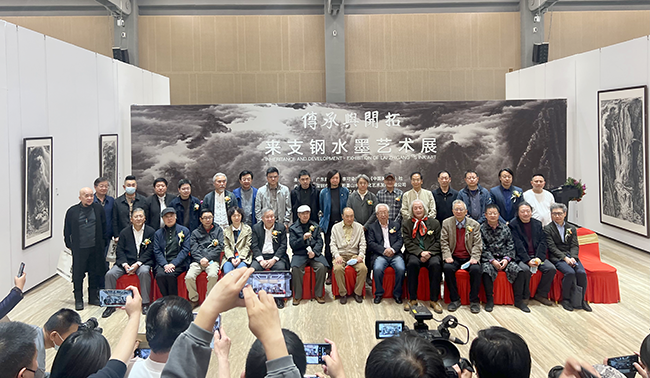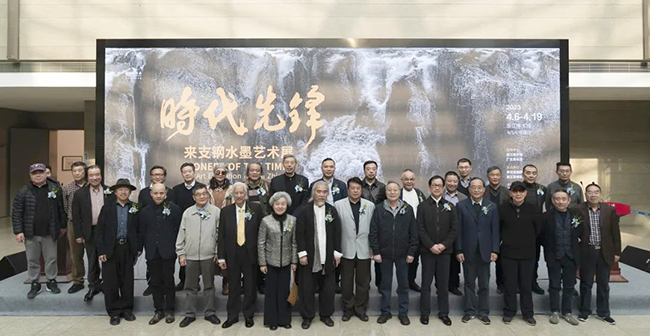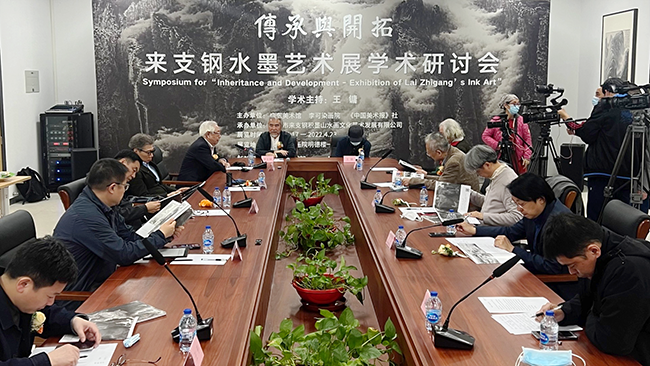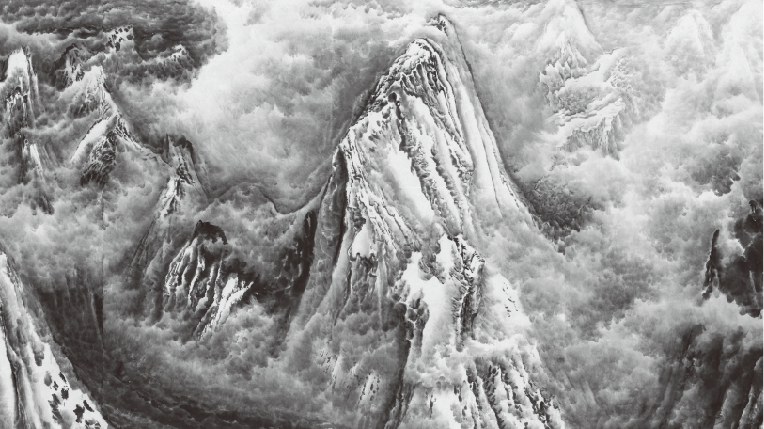当前位置 : 洛杉矶时报增刊
 发布日期:2023/4/28
发布日期:2023/4/28
 来源:International daily
来源:International daily
 打印
打印

The portrait of Lai Zhigang.

Accompanied by Lai Zhigang, Ted Sieong, founder of International Daily News, visited his works in January 2023.

A group photo in the Lai Zhigang Ink-Wash Art Exhibition in China National Academy of Painting in April 2022.

The Group Photo in the Lai Zhigang Ink-Wash Art Exhibition in Guangdong Museum of Art in June 2022.

Symposium on Lai Zhigang Ink-Wash Paintings Exhibition in April 2022.

Sacred Land 250x1375cm(partial) 2020.

Way of Art 1134x249cm 2009.
“The brimming waves delight the eye on sunny days, the dimming hills give a rare view in rainy haze.” The spring in Hangzhou epitomizes the most beautiful region south of the Yangtze River. The ink landscape paintings of Lai Zhigang choose to rival the real scenery in Hangzhou.
Over the recent years, Lai Zhigang has been a high-profile name in the circle of Chinese painting. A dozen of authoritative persons, who have commented favorably on him or spoken highly of him, think that he has pushed the traditional Chinese ink and wash to a new height.
Xiao Feng, former dean of the China Academy of Art, thinks that “his landscape paintings stands out as one of the notable landmarks”; Lu Yushun, dean of the China National Academy of Painting, says that he is “an innovative and creative artist”.
Chen Chuanxi, a famous critic, thinks that his works are “grand and magnificent enough to beat all their peers, and forceful and unrestrained enough to rival the contemporary and historic works”; Wang Dingqian, a veteran collector in Taiwan, says that “Zhang Daqian is unrivalled in ink splashing while Lai Zhigang dominates ink accumulation”.
Chinese paintings, known as art works with traditional Chinese visual aesthetic effects, are essentially characterized by inheritance and innovation. Zou Peizhu, the hostess of Motiange (Li Keran’s wife) before her death inscribed the words “inheritance and exploration” for a painting exhibition of Lai Zhigang. On the basis of inheriting and guarding traditional ink techniques, Lai Zhigang has modernized Chinese ink landscape paintings. Ink accumulation constitutes the core of his artistic achievements.
Gong Xian, Huang Binhong and Li Keran have created point-oriented ink accumulation, linear ink accumulation and large-area inking respectively. Lai Zhigang has integrated the above three skills into one whole and “epitomized the achievements over the past three hundred years” (a quotation from Chen Chuanxi). Li Keran “accumulates ink to create jade” while Lai Zhigang “accumulates water to create jade”. He uses colorless water to neutralize colored ink and enrich Chinese ink and wash. Ink is distilled in water and yields the sense of wonder. Therefore, it can be said that water accumulation can result in the sense of wonder as the highest excellence is like water.
Ink accumulation is a skill and a term in Chinese landscape paintings. As it is a very difficult painting skill, painters mostly are reluctant to study it. When he was a student in the Central Academy of Fine arts, he respectfully declined the suggestion of his teachers and painting companions to “make a detour”, but he has persevered and never stopped pursuing the skill. Finally, he has made his mark at the first shot. Art connoisseurs think that his works merit learning and appreciation.
The souls of Chinese calligraphy and painting originate from traditional Chinese culture. Lai Zhigang, who has profound knowledge of traditional Chinese culture, pursues the highest aesthetic ideas with untiring vigour. In his opinion, water precedes ink in Chinese ink-wash paintings. Water is the “non-being” whole ink is the “being”. As written in Tao Teh King, the things of this world come from Being, and Being comes from Non-being. Therefore, being is created out of non-being. Lai Zhigang follows the spiritual core of the Taoist philosophy and expresses the myriads of changes in the universe in his ink-wash paintings.
The unique artistic aesthetic system of Lai Zhigang’s paintings is epitomized by knowing the white and keeping the black, and using the black to create the white. And embodies the law that the alternation of Yin and Yang constitutes the way. The black can be as black as a crow in night and the white can be as white as an egret amid snow. The black and white world is boundless in artistic conception and charm. The works of Lai Zhigang accord with his painting thoughts that “the simplest world is constituted by Yin and Yang, the black and the white is embodied in ink and wash”, “the way underpins ink, ink is used to realize the way” and “the way originates from ink and wash.”
Lai Zhigang devotes to seeking the truth from facts in the pursuit of self-cultivation, enlightenment and success. He either focuses on creation in his studio or paints from nature. He travels far and wide, including obscure villages, famous mountains and great waters to draw the essence of nature. By grasping the natural law, namely “change”, he copes with all shifting events in painting by sticking to the fundamental principle. As all things are integrated, the universe is just “a stroke of painting” in the spiritual world of Lai Zhigang.
Clouds, water and mountains are all ceaselessly changing, but the central theme remains the same. As said by Song Bing, a painter in the Southern Dynasties, sages illuminate objects by embracing Dao (the way), and virtuous people clear the mind to savor the image. Being broad-minded, Lai Zhigang has depended on profound oriental culture to find the way to great beauty that is infinite in space, volume and energy. Moral achievements are superior to artistic achievements. With commensurate skills, Lai Zhigang employs ink and wash without starting and ending marks and creates works featuring great harmony and unity.
Lai Zhigang, whose gift in painting is bestowed by nature, always follows the natural courses and creates works at his own will without making any draft. As creation involves risks, wonderful views often emerge under his brush, as illustrated by the Chinese sayings that the path winds through high peaks and one suddenly finds a village shaded in soft willows and bright flowers. All things in the universe can be painted, which results from abiding by Dao and sparing no efforts to follow the fundamental principle of eternal changes. With limited wisdom, mankind has to draw support from Dao and integrate with Dao to perceive the ideas that cannot be painted and lead to broader imagination. He often says, “the half of my gains is from hard work, the other is bestowed by nature.”
As said by Jing Hao, an ancient Chinese painter, only by leaving aside all painting skills can lifelike scenery be depicted. These whose spirits and characters stay pure are already immersed in Dao without their own knowledge. The greatest truths are the simplest and become increasingly complicated through evolvement. Like the Creator, Lai Zhigang always copes with complicated things in a simple manner. In a nutshell, he conveys Dao with ink and harness ink with Dao.
To cultivate vital energy by painting, Lai Zhigang continues to break through himself, and works unremittingly to comprehend natural laws, identify with the theory that man is an integral part of nature, make himself act like nature that is selfless, desires for nothing and has no ego and preserve his vitality and spirit to the best of his capability. Kindness is beauty and still waters run deep. According to the doctrine of Zhuang Zhou that empty room makes white, creators have to stay pure and innocent to seek the origin of art and push art to the limit. Only with no ego, a person can overcome worldly thoughts and enter sainthood.
Wang Luxiang, a cultural scholar, disclosed in the Lai Zhigang Beijing exhibition that Li Keran told Li Baolin, a painter, a few days before his death that he would seek abrupt and dramatic changes. How Li Keran will pursue self-improvement remains a mystery. Wang Luxiang believes that the works of Lai Zhigang could probably fulfill the last wish of Li Keran.
Wang Mian, a poet in Yuan Dynasty, once wrote, “Not angling for compliments, I'd be content to let my integrity fill the universe.” Chinese painting shapes the confidence of the Chinese nation in art and is one of the most important cultural relics in oriental civilization. National confidence and pride arise spontaneously in appreciating the works of Lai Zhigang.
Only things of a national touch can prevail in the world. Lai Zhigang, who emerges in response to the new era, is bound to write new chapters in the global palace of art.
Lai Zhigang will display his works again in Hangzhou following many exhibitions held abroad and across the straits. His works, which be said to be the “superlative Chinese ink and wash”, and the West Lake add radiance and beauty to each other. Visitors can gain the best aesthetic enjoyment as both spring rain and ink are fascinating.









